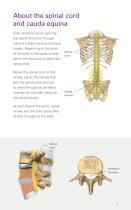
Catalog excerpts

eXtreme Lateral Interbody Fusion This booklet provides general information on XLIF. It is not meant to replace any personal conversations that you might wish to have with your physician or other member of your healthcare team. Not all the information here will apply to your individual treatment or its outcome.
Open the catalog to page 1
About the spine The human spine is made up of 24 bones or vertebrae in the cervical (neck) spine, the thoracic (chest) spine, and the lumbar (lower back) spine, plus the sacral bones. Thoracic Vertebrae are connected by several joints, which allow you to bend, twist, and carry loads. The main joint between two vertebrae is called an intervertebral disc. The disc is made of two parts, a tough and fibrous outer layer (annulus fibrosis) and a soft, gelatinous center (nucleus pulposus). These two parts work in conjunction to allow Sacrum the spine to move, and also provide shock absorption....
Open the catalog to page 2
About the spinal cord and cauda equina Each vertebra has an opening (vertebral foramen) through which a tubular nervous structure travels. Beginning at the base of the brain to the upper lumbar spine, this structure is called the Spinal cord spinal cord. Below the spinal cord, in the lumbar spine, the nerves that exit the spinal cord continue to travel through the vertebral foramen as a bundle known as the cauda equina. Cauda equina At each level of the spine, spinal nerves exit the bony spine then extend throughout the body. Spinal cord Vertebral foramen
Open the catalog to page 3
What can cause pain? There are several primary causes of spine problems. The majority of the symptoms are caused by either instability or by disc, bone, or ligaments pressing onto the nerve roots and/or spinal cord. Degenerative Disc Disease (DDD) During the natural aging process, the discs between each vertebral body can lose their flexibility, height, and elasticity which can cause a tear in the tough outer layer of the disc, causing the disc to herniate, bulge, or leak the gelatinous core. The bulges or leakages can end up compressing the nerve roots and/or spinal cord, causing symptoms...
Open the catalog to page 4
What are the treatment options? Many symptoms can be treated without surgery including rest, heat, ice, medication, injections, and physical therapy. It is important to speak with a physician about the best option. If symptoms do not improve with conservative treatment, physicians may recommend spinal surgery. Surgery is reserved for those who do not gain relief from non-operative forms of treatment, patients whose symptoms are increasing or worsening, and/or patients that present with a spinal condition which indicates the need for surgery. Many symptoms can be treated without surgery...
Open the catalog to page 5
If you require spinal surgery, your physician may determine that the XLIF procedure is a good option for you. Some examples of pathologies (conditions) that may benefit from the XLIF procedure include: • Degenerated discs and/or facet joints that cause unnatural motion and pain • Slippage of one vertebra over another (degenerative spondylolisthesis) • Change in the normal curvature of the spine (degenerative scoliosis) Conversely, your physician may determine that an XLIF procedure is not a good option for you. It is important to discuss this with your physician in order to determine the...
Open the catalog to page 6
What to expect Before surgery Your physician will review your condition and explain treatment options, including medications, physical therapy, and other surgeries. Should you have any questions regarding the procedure, do not hesitate to ask your surgeon. Your physician will provide thorough preoperative instructions.
Open the catalog to page 7
During surgery After you are sedated, positioned on your side, and surrounded by the appropriate surgical draping, an x-ray image is taken of your spine to identify the location of the operative disc space. Step 1: Approach Your surgeon will make a small incision on the lateral (side) of your body. Dilators Minimally disruptive retractor will be used to direct the path to the affected disc space while monitoring the local nerves. Once the optimal path has been determined, a retractor will be utilized to hold the skin incision open, providing access and visibility to the affected area. Step...
Open the catalog to page 8
What implants are used? Below are some examples of the implants that may be used during your XLIF ® procedure: Pedicle screws and rods Interbody implant Postsurgical view Two-level lumbar XLIF with pedicle screw and rod fixation Single-level lumbar XLIF with plate
Open the catalog to page 9
After surgery After surgery you will wake up in the recovery room, where your vital signs will be monitored and your immediate postoperative condition will be carefully observed. Once the medical staff feels that you are doing well, you will be returned to your room in the hospital. Your physician will determine the best postoperative course for you. The day after your surgery, your physician may instruct you to use a brace for a period of time to assist with the spinal fusion process. Supervised by trained medical professionals, your physician may ask you to carefully sit, stand, or walk....
Open the catalog to page 10
Frequently asked questions Can I shower after surgery? Depending on your surgical incision, you may have showering restrictions. Ask your physician for appropriate instructions. Will I have a scar? Your physician will discuss the incisions that will be made during an XLIF ® surgery. When can I drive? For a period of time after your surgery, you may be cautioned about activities such as driving. Your physician will tell you when you may drive again. Can I travel? The implants used in the XLIF procedure may activate a metal detector. Because of increased airport security measures, please call...
Open the catalog to page 11
What are the potential benefits of an XLIF procedure? ® Benefits of an XLIF procedure, when compared to traditional lumbar interbody fusion surgery, may include: • Smaller incision • Less blood loss during surgery • Reduced operative time • Reduced hospital stay • Reduced postoperative recovery time Traditional lumbar XLIF surgery Blood loss Hospital stay interbody fusion surgery The above data represents typical outcomes of patients being treated for degenerative disc disease, spondylolisthesis, and scolio
Open the catalog to page 12All NuVasive catalogs and technical brochures
-
ALIF
16 Pages
-
PCF
12 Pages
-
CTDR
4 Pages
-
ACDF
12 Pages
-
XLIF® CORPECTOMY
12 Pages






